Name HSV-2 Swift Yard number 061 Out of service 2013 Launched 15 August 2003 Beam 28 m | Ordered October 2002 Acquired 15 August 2003 Refit October 2008 Length 98 m | |
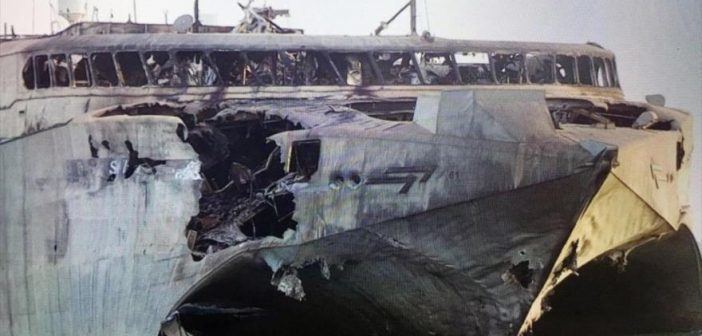 | ||
HSV-2 Swift is a hybrid catamaran. She was privately owned and operated by Sealift Inc., and was originally built under the JHSV program as a proof of concept. As part of this program, she was directly leased for evaluation from her builders by the United States Navy Military Sealift Command from 2003 to 2013, primarily as a mine countermeasures and sea basing test platform. Later during her official naval career she was mostly used for fleet support and humanitarian partnership missions.
Contents
- Design and description
- Construction and acquisition
- US flagged service
- Later service
- Related developments
- References
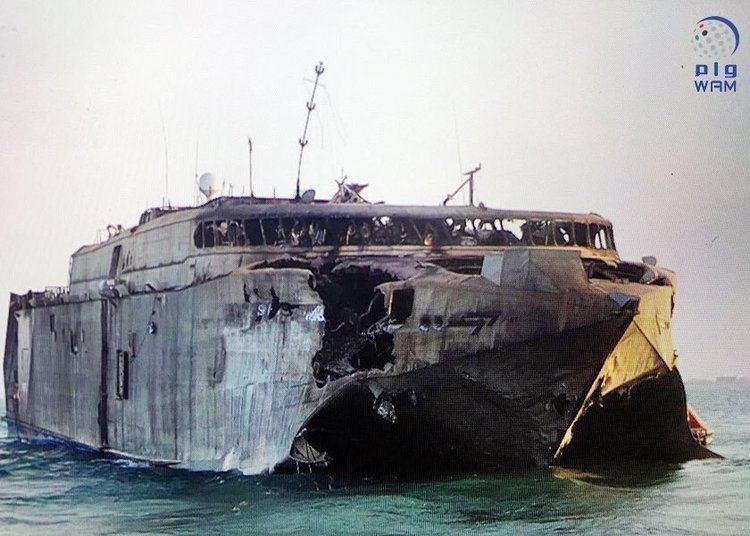
As of 2015, the ship was reported to have been leased by the United Arab Emirates' National Marine Dredging Company. On 1 October 2016, the ship was attacked and seriously damaged off Yemen. Houthi rebels claimed the ship sank. According to unnamed US Department of Defense officials, the damaged ship was being towed to Eritrea.
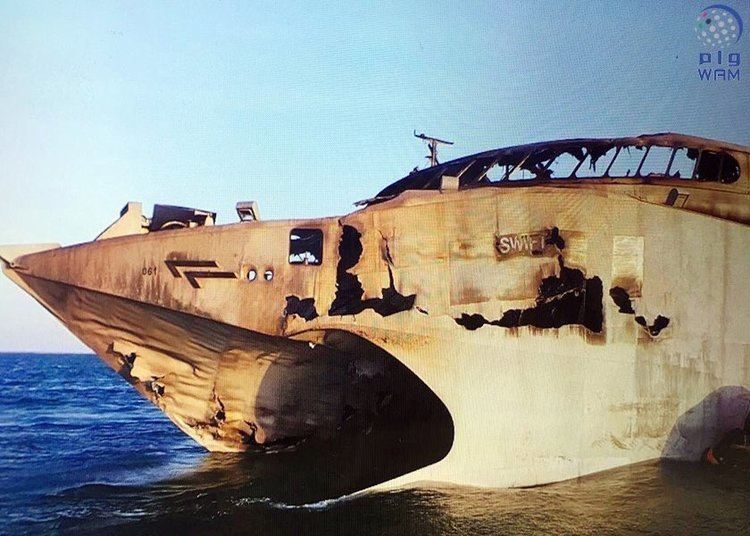
Design and description

The ship is a wave-piercing, aluminum-hulled, commercial catamaran with military enhancements, such as a helicopter flight deck, vehicle deck, small boat and unmanned vehicle launch and recovery capability, and a communications suite. She features a new, modular design, which will allow her to be refitted to support missions without requiring long shipyard periods. While from the front the vessel looks like a trimaran, the center hull does not rest in the water and is not used for buoyancy. As a logistics vessel, the ship does not have water-tight compartments or weapons systems. Propulsion is provided by directional water jets, so the ship does not have propellers or a rudder for steering, and can maneuver in 3.7 m (12 ft) of water.
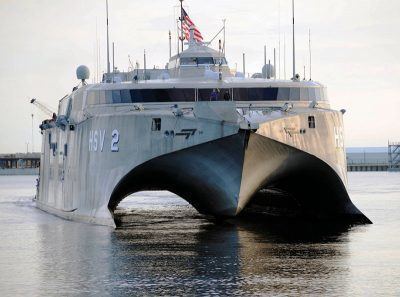
The HSV stands for "High Speed Vessel", and her home port while chartered as a MSC vessel was Naval Amphibious Base Little Creek in Norfolk, Virginia. The vessel had two CONMAR crews that typically rotated every three months to keep the ship deployed eleven months per year. The minimum crew size is 35; during her time with the MSC 18 were military with the balance civilian, provided through American Maritime Officers and Seafarers International Union of the United States Merchant Marine. On rare occasion that she was in a United States port, it was usually Naval Station Mayport, Florida, supporting the Fourth Fleet or Charleston, South Carolina, for major maintenance. Rota, Spain, was considered by the crew to be the "Mediterranean home away from home.
Construction and acquisition
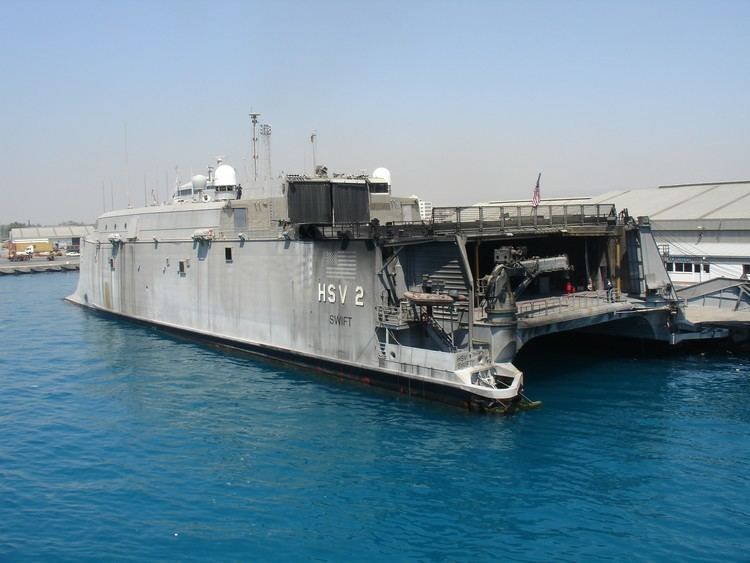
The ship was constructed by the Australian shipbuilder Incat in Hobart, Tasmania, and was leased to the U.S. Navy through Bollinger/Incat of Lockport, Louisiana. She was the second catamaran the Navy leased to test new technologies and concepts associated with the Chief of Naval Operations's "Sea Power 21" plan. The contract value for the first year was $21.7 million.

Swift is the fourth Incat-built high-speed wave piercing catamaran to enter military service, following behind HMAS Jervis Bay, United States Army Vessel (USAV) Theater Support Vessel Spearhead (TSV-X1) and USS Joint Venture.
US flagged service
The first ship of this class to be used by the Navy, HSV-1 Joint Venture, proved its military mettle during the 2003 invasion of Iraq as a forward staging platform for Marine Fleet Anti-Terrorism and United States Navy SEAL (SEa, Air, Land) teams in the shallow waters of Umm Qasr, Iraq. The Navy hoped to build upon lessons learned from Swift and its predecessor, and eventually use the information to create a new class of littoral combat ships.
In the autumn of 2003, while operating with the Fifth Fleet, Swift completed the fastest-ever transit of the northern Great Barrier Reef from Cairns to Booby Island, Australia, averaging slightly over 39 knots (72 km/h). During flight deck certifications, Swift's crew conducted aircraft recovery while making 43 knots (80 km/h) during one recovery and had 66-knot (122 km/h) apparent winds during another recovery.
In November 2003 she began West African Training Cruise-04. She first visited the South African Navy (SAN) base at Durban on 3 November 2003. She then exercised with the SAN and the South African Air Force off Simon's Town in the Western Cape. As of early November 2003, as reported by Jane's Defence Weekly on 19 November 2003, exercises were also planned with Cameroon, Gambia, Ghana, Morocco, Senegal, and Sierra Leone. Swift had embarked a small United States Marine Corps (USMC) detachment for the cruise, 'which will draw on Norway Air-Landed Marine Expeditionary Brigade equipment for the exercises.' The Jane's Defence Weekly story said that Marine reservists will practice with the NALMEB equipment, and the cruise would also be used to evaluate an experimental lightweight ROWPU that was at that time being tested by the USMC warfighting laboratory. The vessel returned in early 2004.
In January 2005, Swift was tapped to provide logistical assistance during the Tsunami Relief Effort in North Sumatra. Swift departed Naval Station Ingleside, Texas, on 3 January 2005. Swift was in Pearl Harbor 15 January 2005, on the way to provide assistance following the Tsunami. The ship arrived in Singapore on 30 January 2005, Belawan, Indonesia 3 February 2005 and Sattahip, Thailand, on 7 February 2005.
Prior to arriving in the Tsunami affected region, crews were swapped in Pearl Harbor, with Gold crew relieving Blue crew in less than eight hours. Swift embarked a helicopter detachment, and served as a base of operations for two helicopters and their crew for 30 consecutive days at sea. During the operation, Swift sailed for 30 straight days, supported a helicopter detachment and support crew and conducted two underway replenishments.
In 2005, Swift played a major role in Hurricane Katrina relief efforts. With most roads inaccessible along the Gulf Coast, Swift and its crew delivered the necessary supplies by water, traversing the Mississippi River multiple times hauling humanitarian aid between Pensacola, Florida, and New Orleans, Louisiana.
During the 2006 Israel-Lebanon conflict, HSV-2 Swift was used to transport humanitarian assistance materials from Cyprus to Beirut.
Swift departed Naval Station Mayport, Florida, on 25 April 2007, to serve as a Global Fleet Station (GFS). The ship hosted more than 1,000 host nation military and civilian personnel during twelve visits to seven countries such as Belize, Dominican Republic, Guatemala, Honduras, Jamaica, Nicaragua and Panama. In these countries, personnel on board Swift conducted 39,890 hours of subject matter expert exchanges in such areas as leadership, small boat operations, port security and small unit tactics.
The six-month US Navy sponsored GFS deployment tested the Navy’s GFS concept, a maritime security cooperation initiative aimed at strengthening global partnerships through training and cooperation activities. Swift transported US military training teams to conduct maritime training with regional civil and maritime services.
During the last half of the deployment, more than 20,000 lb (9,100 kg) of medical and food supplies were donated through Project Handclasp. Swift hosted numerous dignitaries, including the Prime Minister of Jamaica and U.S. Ambassadors to Panama, Guatemala, Nicaragua, Honduras and Jamaica.
The GFS completed its pilot mission, Sunday, 30 September 2007, when Swift returned to Naval Station Mayport, Florida.
On 5 May 2010, HSV-2, along with various embarked Navy and Marine Corps units, departed Naval Station Mayport for a five-month deployment for Southern Partnership Station (SPS) 2010.
In April 2013, a TIF-25K Tethered Aerostat (unmanned blimp) was tested from the stern of HSV-2. The aerostat could be positioned 3,000 feet (910 m) above the vessel for surveillance.
Swift was to be replaced with USNS Spearhead when that vessel came into service. Originally chartered in July 2003 as an interim mine warfare command and support ship for "transformational" mine warfare modular mission payload initiatives, the ship had been sent to the Persian Gulf, South Africa, the North Sea, and Hawaii within one year. Other locations included the Gulf of Mexico, Singapore, Thailand, Sicily, Spain, and southern California. As mine demonstration missions wore down, Swift was used in partnership missions, performing extended cruises to Africa, the Caribbean, and Central and South America. The five-year charter was renewed in 2008, and the ship continued to serve until the introduction of Joint High Speed Vessels. HSV-2 Swift ended its service with Military Sealift Command in 2013.
Later service
Swift returned to Incat at Hobart in July 2013 for refit for sale or charter. As of July 2015 the vessel was reportedly being operated by the UAE's National Marine Dredging Company.
Houthis fighters claimed to have sunk the Swift off the Yemeni coast (in the Bab-el-Mandeb strait) around 1 October 2016. The UAE military reported Swift had been involved in an "incident" and said there were no casualties, but did not say whether the ship was damaged. UAE officials reported that the ship was carrying aid when it was attacked. Saudi Arabia reported that their forces rescued passengers from a damaged UAE ship at dawn on 1 October 2016. There currently seems to be some confusion as to whether she was enroute to Aden (apparently a regular destination) or Mokha at the time she was attacked. Unnamed US Defense officials reported that four "shoulder-fired rockets" were used in the attack, but Houthis said it was a C-802/Noor anti-ship missile. US Defense officials said that Swift was in tow to Eritrea as of 3 October 2016. Later photographs proved that she is still afloat, albeit heavily damaged, as of 5 October 2016. The government of the UAE expects to salvage her, and insurance has covered the loss of the ship. The ship was declared unrepairable and decommissioned. According to open source naval analyst and retired Navy Captain Chris Carlson, the shrapnel damage to Swift indicates she was hit by EFP warhead, most likely a C-802 as previously reported.
US destroyers USS Mason and USS Nitze, and amphibious transport dock USS Ponce were dispatched to the area "to ensure that shipping continues unimpeded in the strait and the vicinity." Mason and Ponce were subsequently attacked on 9 October. Mason was attacked again on 12 October and on 15 October.
